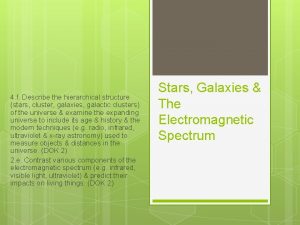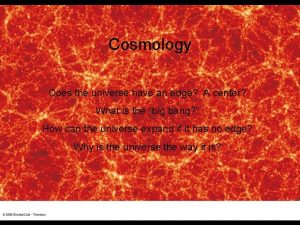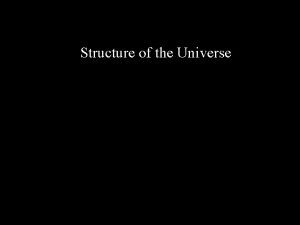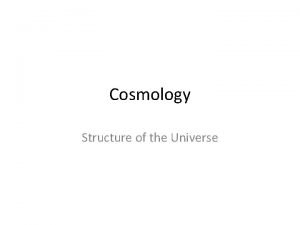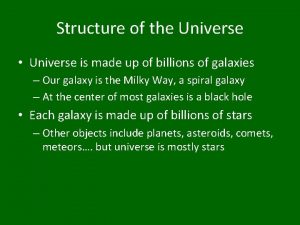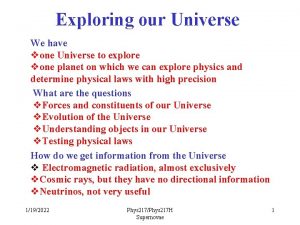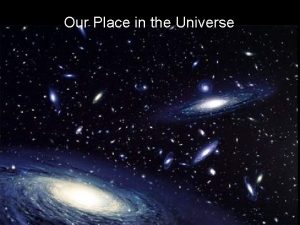Structure of the Universe What does our universe



















- Slides: 19

Structure of the Universe What does our universe look like?

Galaxies • Galaxy- collection of billions of stars and various amounts of gas and dust held together by gravity – Average galaxy has 100 billion stars

Galaxy • Galaxies have been classified on shape – Elliptical – Irregular – Spiral

Galaxy • Milky Way Galaxy- our solar system is part of this spiral shaped galaxy – 200 billion stars

Galaxy

Stars • Star- large ball of gas held together by gravity that produces tremendous amounts of energy and shines – Make up the majority of known matter in a galaxy

Stars • Energy Production: – Nuclear Fusion- the combining of nuclei of smaller elements to form the nuclei of larger elements – The Sun converts hydrogen nuclei into helium nuclei

Stars • Luminosity and Temperature: – Luminosity- a measure on how bright a star is compared to our Sun – Luminosity and temperature are used in classifying the different types of stars

Stars

Star Types • Our Sun (medium sized star) is 109 times bigger then Earth • Most stars are bigger the Earth

Star Types • Main Sequence Stars: – 90 % of stars studied and located on the Luminosity and Temperature of Stars Diagram fall on a broad band grouped together – Most Stars spend their life here – These are your average size, temperature, and luminosity

Star Types • Giant Stars: – Red, orange, and yellow giant stars – Commonly seen because of their size – Low-temperature stars in late stages of their evolution

Star Types • Super Giants: – 100 to 1000 times the size of our Sun – Highly luminous – Late stage development and usually explode in an event called a supernova – Blue super giants are the brightest and exhibit the highest temperature

Star Types • White Dwarfs: – Around the size of the Earth – Hot on the surface – Low in luminosity

Star Types • Black Dwarfs: – After a white dwarf cools and no longer emits electromagnetic energy it is a “dead star” or black dwarf – Common in the universe because many have used up their supply of hydrogen and can no longer main nuclear fusion

Star Types


Star Origin and Evolution • Stars have an evolution--- origin, life, and ending – Originate from clouds of dust and gas – Gravity causes them to clump up forming larger balls of dust and gas – When gravitational contraction creates enough heat they start nuclear fusion

Star Origin and Evolution • Stars spend most of their lives as a main sequence star – Massive stars then can undergo a supernova and create a black hole (extremely high mass) or a neutron star – Lower mass stars become a white dwarf and burn out into a black dwarf
 Thinking language and intelligence
Thinking language and intelligence Our census our future
Our census our future Longing for peace our world is troubled
Longing for peace our world is troubled Marcus aurelius our life is what our thoughts make it
Marcus aurelius our life is what our thoughts make it We bow our hearts
We bow our hearts Our census our future
Our census our future Our life is what our thoughts make it
Our life is what our thoughts make it Money madness
Money madness Our awareness of ourselves and our environment
Our awareness of ourselves and our environment Awareness of ourselves and our environment is
Awareness of ourselves and our environment is God our father christ our brother
God our father christ our brother Our future is in our hands quotes
Our future is in our hands quotes Awareness of ourselves and our environment is
Awareness of ourselves and our environment is Our awareness of ourselves and our environment
Our awareness of ourselves and our environment Which type of star cluster is loose and disorganized?
Which type of star cluster is loose and disorganized? Structure and evolution of the universe. lesson 1
Structure and evolution of the universe. lesson 1 Does the universe have an edge
Does the universe have an edge Hát kết hợp bộ gõ cơ thể
Hát kết hợp bộ gõ cơ thể Slidetodoc
Slidetodoc Bổ thể
Bổ thể














